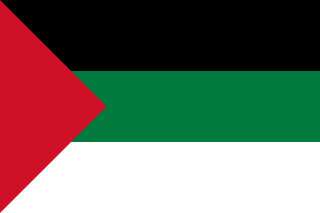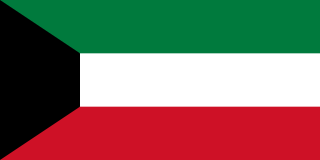Kuwait is a sovereign state in Western Asia located at the head of the Persian Gulf. The geographical region of Kuwait has been occupied by humans since antiquity, particularly due to its strategic location at the head of the Persian Gulf. In the pre-oil era, Kuwait was a regional trade port. In the modern era, Kuwait is best known for the Gulf War (1990–1991).
The 630s decade ran from January 1, 630, to December 31, 639.

Year 633 (DCXXXIII) was a common year starting on Friday of the Julian calendar. The denomination 633 for this year has been used since the early medieval period, when the Anno Domini calendar era became the prevalent method in Europe for naming years.

The pan-Arab colors are black, white, green and red. Individually, each of the four pan-Arab colors were intended to represent a certain aspect of the Arab people and their history.

The Muslim conquest of Persia, also called the Muslim conquest of Iran, the Arab conquest of Persia, or the Arab conquest of Iran, was a major military campaign undertaken by the Rashidun Caliphate between 632 and 654. As part of the early Muslim conquests, which had begun under Muhammad in 622, it led to the fall of the Sasanian Empire and the eventual decline of Zoroastrianism, which had been predominant throughout Persia as the nation's official religion. The persecution of Zoroastrians by the early Muslims during and after this conflict prompted many of them to flee eastward to India, where they were granted refuge by various kings.

Hammam Ibn GhalibAl-Tamimi, more commonly known as Al-Farazdaq (الفرزدق) or Abu Firas, was a 7th-century Arab poet and orator who was born in the Rashidun Caliphate of Umar and flourished during the Umayyad Caliphate. He had a great impact on the Arabic Language and it is said that “If it were not for Al-Farazdaq’s poetry, a third of the Arab language would not have been.”

Failaka Island is a Kuwaiti Island in the Persian Gulf. The island is 20 km off the coast of Kuwait City in the Persian Gulf. The name "Failaka" is thought to be derived from the ancient Greek φυλάκιο(ν) – fylakio(n) "outpost".
Umm al Namil is an island belonging to Kuwait, located within Kuwait Bay, in Persian Gulf. The island is at shortest, 600 metres away from the Kuwaiti mainland.
Shuwaikh Island, also known as Akkaz Island, is a former island of Kuwait within Kuwait Bay. The former island is now joined to Kuwait's Shuwaikh industrial area as an extension via land bridge and therefore no longer exists as an island.

Kuwait, officially the State of Kuwait, is a country in West Asia. It is situated in the northern edge of the Arabian Peninsula at the tip of the Persian Gulf, bordering Iraq to the north and Iran with the Persian Gulf and Saudi Arabia to the south. With a coastline of approximately 500 km (311 mi), Kuwait also shares a maritime border with Iran. Most of the country's population reside in the urban agglomeration of Kuwait City, the capital and largest city. As of 2023, Kuwait has a population of 4.82 million, of which 1.53 million are Kuwaiti citizens while the remaining 3.29 million are foreign nationals from over 100 countries. In 2024 the population of Kuwait has risen to 4.93 million which is a population increase of 1.98% from 2023.

The Battle of Walaja was fought in Mesopotamia (Iraq) in May 633 between the Rashidun Caliphate army under Khalid ibn al-Walid and Al-Muthanna ibn Haritha against the Sassanid Empire and its Arab allies.

The Battle of Ullais was fought between the forces of the Rashidun Caliphate and the Sasanian Persian Empire in the middle of June 633 AD in Iraq, and is sometimes referred to as the Battle of Blood River since, as a result of the battle, there were enormous amounts of Persian Sasanian and Arab Christian casualties.

The Battle of Hira was fought between the Sasanian Empire and the Rashidun Caliphate in 633. It was one of the early battles of the Muslim conquest of Persia, and the loss of the frontier city on the Euphrates River opened the way to the Sasanian capital at Ctesiphon on the Tigris River.

Jōn al Kuwayt, also known as Kuwait Bay, is a bay in Kuwait. It is the head of the Persian Gulf. Kuwait City lies on a tip of the bay.

The Battle of Sallasil, often referred to as the Battle of Chains, was the first battle fought between the Rashidun Caliphate and the Sasanian Persian Empire in April 633. The battle was fought in Kazima by the forces of Khalid ibn al-Walid and the Persians under Hormozd. It was fought soon after the Ridda Wars were over and the Arabian Peninsula was united under the authority of the Caliph Abu Bakr. Indeed, it was the first battle of the Rashidun Caliphate in which the Muslim army elected to extend its frontiers outside of Arabia, thus initiating the Arab conquests.
The Rashidun army was the core of the Rashidun Caliphate's armed forces during the early Muslim conquests in the 7th century. The army is reported to have maintained a high level of discipline, strategic prowess and organization, granting them successive victories in their various campaigns.
The Fursan unit, or the early Muslim cavalry unit, was the cavalry forces of the Rashidun army during the Muslim conquest of Syria. The division, which formed the early cavalry corps of the caliphate, was commonly nicknamed the Mobile Guard or the Marching Army. These units were commanded by Khalid ibn al-Walid, an early caliphate cavalry commander who organized the unit into military staff – a simple beginning of what later in military history would emerge as the general staff. Khalid had collected from all the regions in which he had fought – Arabia, Iraq, Syria and Palestine.
Arfajah ibn Harthama al-Bariqi was a companion of the Islamic prophet Muhammad. He was a member of the Azd branch of the Bariq clan that inhabited Southwestern Arabia.
Subiya or al-Subiyah is a region in northern Kuwait on the north coast of Kuwait Bay (Kuwait), consisting of several micro-regions: Bahra, H3, Nahdain, Radha, Muhaita, Mughaira, Dubaij, and Ras al-Subiyah. The area features archaeological sites with tumuli graves, settlements, campsites, wells, and shell middens. Most of the tumuli date to the Early and Middle Bronze Age. Subiya is the location of the Silk City project, the project's first phase was launched in May 2019.
The United Arab Emirates (UAE) is a relatively new country – it was formed in 1971. However, the history of the land that the UAE occupies dates back to the Neolithic Age, which is evidenced by inscriptions, drawings and archaeological finds uncovered in the seven emirates during the period from the early 1950s to the present day.












